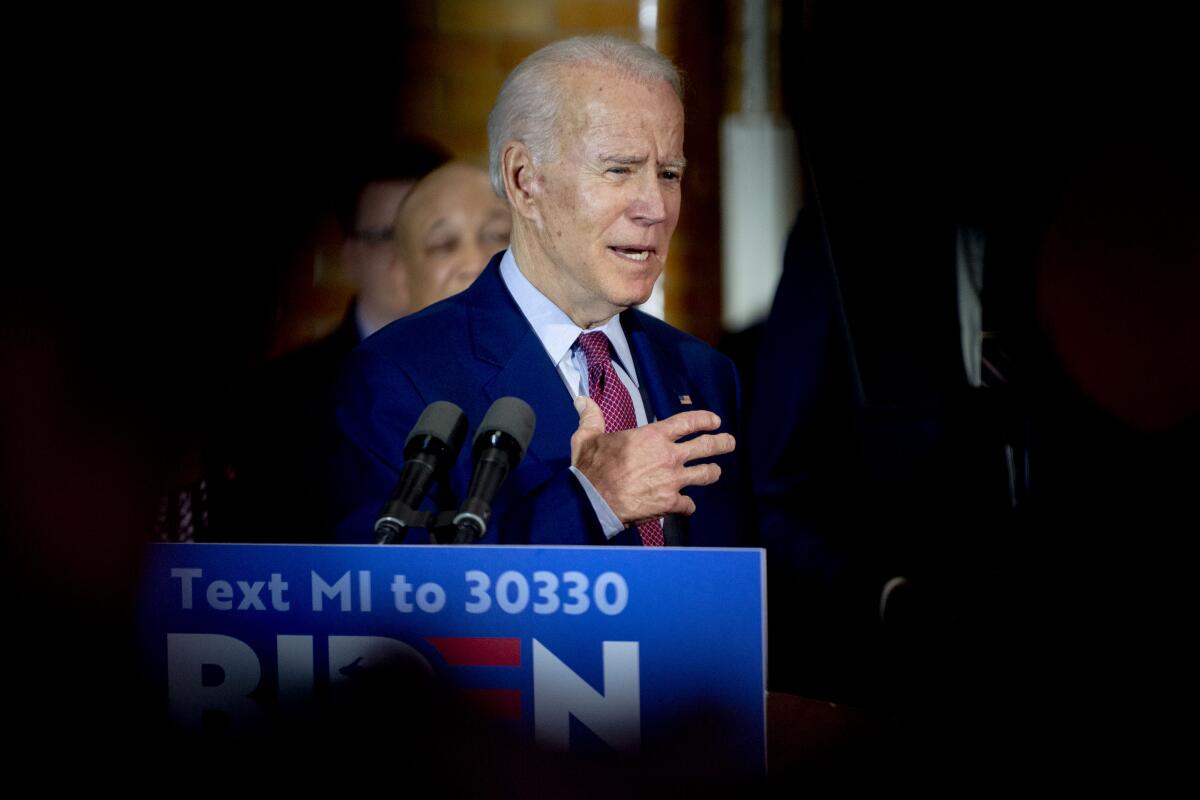Can Biden beat Trump? Michigan’s swing districts offer good clues

- Share via
It may be early to be making predictions about what will happen in the presidential election eight months from now. But there’s good news for Joe Biden if you dig into the district-by-district results from Michigan’s Democratic primary last week. I found strong evidence that he’s building a diverse coalition of support that, if maintained, could win him the state and the electoral college vote come November.
Biden’s primary victory in Michigan kept his momentum going and did serious damage to Bernie Sanders’ chances for the nomination. Equally important is how Biden won in Michigan. On Tuesday, we’ll hear from two more big swing states, Florida and Ohio, as voters there cast their primary ballots. But first, here’s what we can glean from the Michigan contest.
What stands out about Biden’s performance was his ability to draw support from voters in every kind of congressional district — liberal urban districts with many young people and people of color, moderate suburban districts, and districts that swung heavily for Donald Trump in 2016. If he is to win Michigan in November, he has to gain more support than Hillary Clinton had in the 2016 presidential election. His performance in the primary, compared with Clinton’s primary performance in 2016, suggests he is improving on the size and diversity of her coalition.
Michigan was a crucial swing state in 2016 and is likely to be again in 2020. It contains congressional districts that run the political gamut. For instance, the 13th District is represented by Rashida Tlaib, a member of the Democratic Socialists of America. The 8th District, which went for Trump in 2016, is now represented by Elissa Slotkin, a moderate Democrat who defeated a Republican incumbent in the 2018 midterm election. The 4th District is a solid Republican district, held by John Moolenaar, a Trump supporter.
Biden not only won in the 13th, 4th, and 8th districts, he won more votes than Sanders in every one of Michigan’s 14 congressional districts. He also got more votes in every district than Sanders did in the 2016 primary, when he won the Michigan primary. This indicates that Biden appeals to Democrats and independents of many different backgrounds and political preferences.
Biden’s primary election support was large and geographically dispersed. Turnout was up across the state, with Biden receiving 838,259 of the 1.5 million votes cast in the Democratic primary (there was a separate Republican primary). He won more primary votes than Clinton did in the 2016 primary in all but one district. On average, Biden received 18,742 more votes per district than Clinton’s primary tallies.
While the primary electorate is different than the general electorate, primary support can be a leading indicator of the general election. These results show that Biden was able to mobilize voters who did not support Clinton in 2016, which could be important in the general election.
In the nine Michigan congressional districts where Trump received more votes than Clinton in 2016, Biden won an average of 23,753 more primary votes than did Clinton in the 2016 primary. In the five districts that Clinton won in the presidential election, Biden picked up an average of 9,722 more primary votes than Clinton had. Biden’s primary support was stronger than Clinton’s had been in almost every congressional district, but especially so in Trump territory. If some of these primary voters who turned out for Biden but did not vote for Clinton in 2016 continue to support him in November, Trump’s 12,000-vote statewide margin in 2016 could vanish.
In the Democratic wave that took the House in 2018, Democratic candidates in five Michigan districts (1st, 5th, 7th, 8th and 11th) received more votes than Clinton did in the 2016 general election. In these districts, Biden won an average of 23,949 more primary votes than Clinton did in the 2016 primary. In the two districts that flipped from Republican to Democrat in 2018, Biden received 27,726 and 36,299 more votes in the primary than had Clinton.
There are differences between the 2016 and 2020 primaries. In 2016, there was a competitive primary on the Republican side. Because Michigan has an open primary, some people who voted in the 2016 Republican primary may have voted in the Democratic primary this year. The question is whether this group of voters, many of whom appear to have turned out for Biden, will stick with the Democratic nominee in November.
While we can’t know for certain how these trends will translate in the general election, Biden won votes across all of Michigan — and of special importance, in places where Democrats saw large gains in 2018 and that Trump won in 2016. That broad base of support in a big swing state is promising for building an electoral college majority.
Seth Hill is an associate professor of political science at UC San Diego who studies how citizens motivate politician behavior.
More to Read
A cure for the common opinion
Get thought-provoking perspectives with our weekly newsletter.
You may occasionally receive promotional content from the Los Angeles Times.









